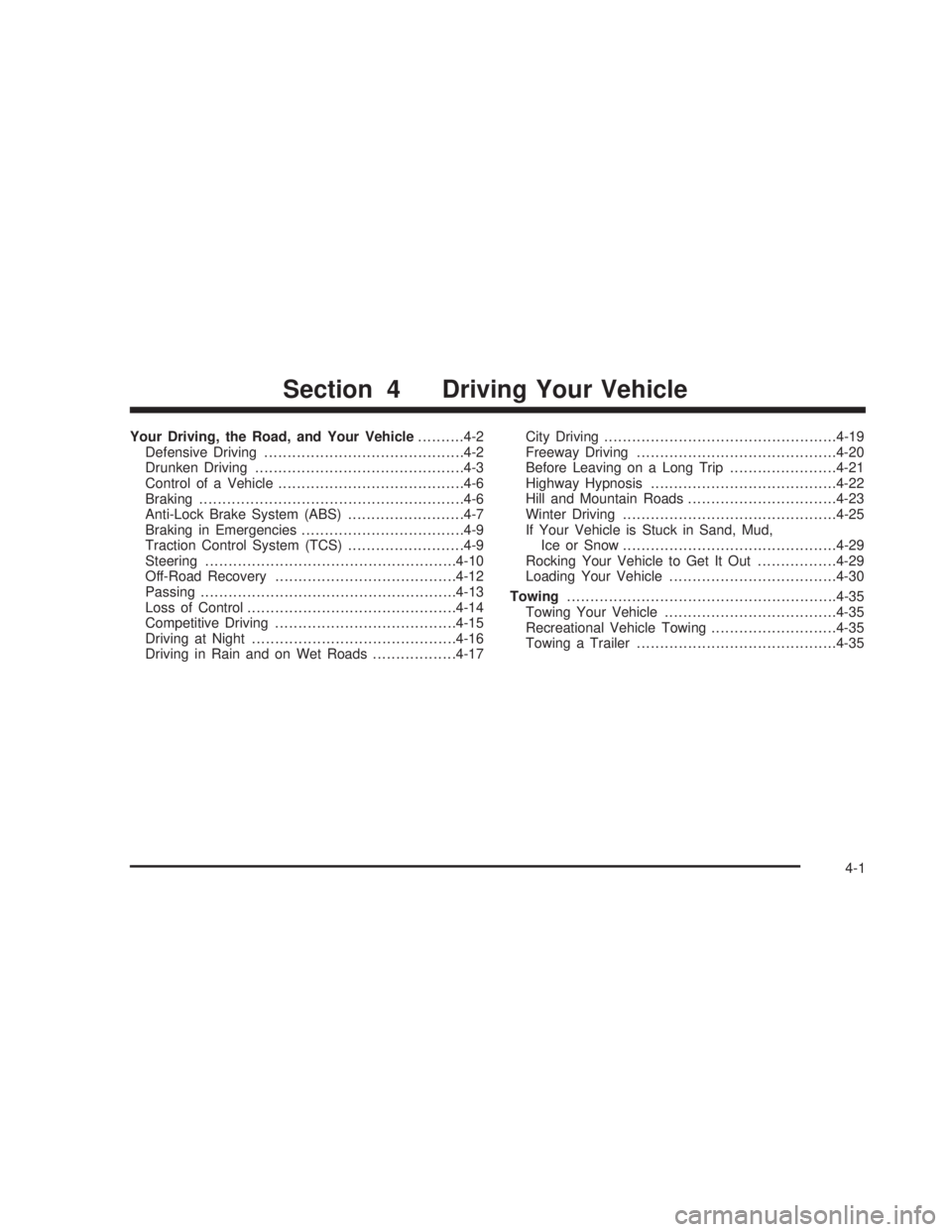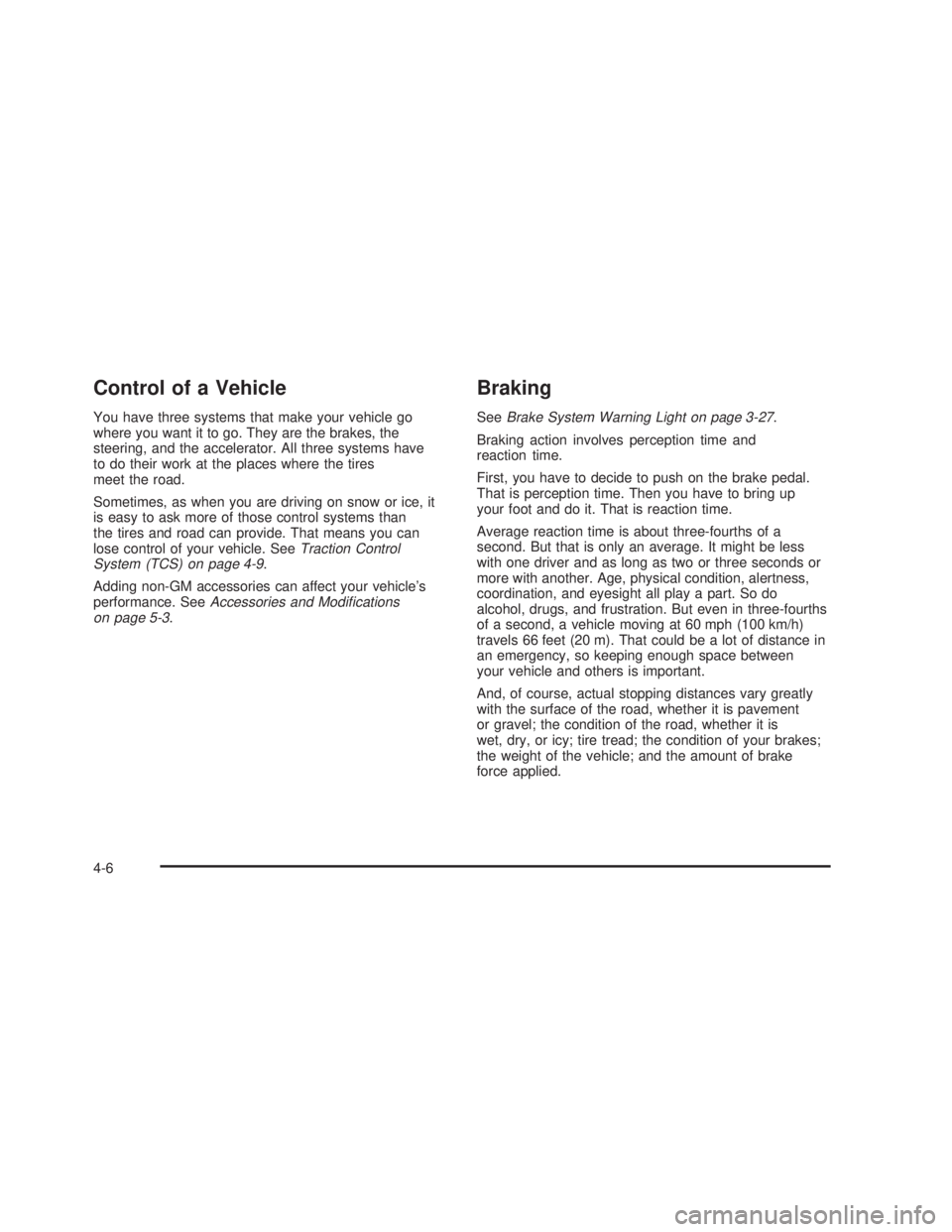traction control PONTIAC GTO 2006 Owners Manual
[x] Cancel search | Manufacturer: PONTIAC, Model Year: 2006, Model line: GTO, Model: PONTIAC GTO 2006Pages: 326, PDF Size: 1.62 MB
Page 103 of 326

The main components of the instrument panel are the following:
A. Side Outlets. See
Outlet Adjustment on page 3-21.
B. Exterior Lamp Controls. See
Instrument Panel
Brightness on page 3-15andExterior Lamps on
page 3-13.
C. Instrument Panel Cluster. See
Instrument Panel
Cluster on page 3-23.
D. Windshield Wiper Lever. See
Windshield Wipers on
page 3-9.
E. Trip Computer Control. See
Trip Computer on
page 3-33.
F. Outlets. See
Outlet Adjustment on page 3-21.
G. Hazard Warning Flasher Button. See
Hazard
Warning Flashers on page 3-6.
H. Climate Controls. See
Climate Control System on
page 3-19.
I. Audio System Controls. See
Audio System(s) on
page 3-44.J. Cruise Control Lever. See
Cruise Control on
page 3-10.
K. Audio Steering Wheel Controls. See
Audio Steering
Wheel Controls on page 3-56.
L. Tilt Wheel. See
Tilt Wheel on page 3-6.
M. Horn. See
Horn on page 3-6.
N. Ignition Switch. See
Ignition Positions on page 2-16.
O. Shift Lever. See
Automatic Transmission Operation
on page 2-19orManual Transmission Operation
on page 2-21.
P. Cupholders. See
Cupholder(s) on page 2-30.
Q. Traction Control System and Power Door Lock
Buttons. See
Traction Control System (TCS)
on page 4-9andDoor Locks on page 2-7.
R. Parking Brake. See
Parking Brake on page 2-24.
S. Glove Box. See
Glove Box on page 2-30.
3-5
2006 - Pontiac GTO Owner Manual
Page 109 of 326

{CAUTION:
Cruise control can be dangerous where you
cannot drive safely at a steady speed. So, do
not use your cruise control on winding roads
or in heavy traffic.
Cruise control can be dangerous on slippery
roads. On such roads, fast changes in tire
traction can cause excessive wheel slip, and
you could lose control. Do not use cruise
control on slippery roads.
Setting Cruise Control
{CAUTION:
If you leave your cruise control on when you
are not using cruise, you might hit a button
and go into cruise when you do not want to.
You could be startled and even lose control.
Keep the cruise control switch off until you
want to use cruise control.The cruise control lever is on the left side of the
steering column. The ON-OFF/CANCEL switch is at the
end of the lever and is activated by pushing in towards
the direction of the steering column.
To set cruise control, do the following:
1. Turn on the ignition.
2. Press the ON-OFF/CANCEL switch. The CRUISE
message appears on the trip computer.
3. Get up to the speed you want.
4. Rotate the lever down to SET-DECEL. The CRUISE
ACTIVE message appears on the trip computer.
5. Take your foot off the accelerator pedal and release
the cruise control lever.
Adjusting Speed While Using Cruise
Control
You may do one of the following:
·Turn the lever down to SET-DECEL until the car
slows down to the desired speed, then release it.
·Turn the lever up to RES-ACCEL until the car
accelerates up to the desired speed, then release it.
Minor changes in speed can be achieved by
momentarily turning the lever up or down. When
reducing speed, remember that the cruise control is not
designed to operate under 25 mph (40 km/h).
3-11
2006 - Pontiac GTO Owner Manual
Page 110 of 326

Pausing Cruise Control
To pause cruise control, press the brake pedal on either
an automatic or manual transmission, or the clutch
pedal on a manual transmission, or press the
ON-OFF/CANCEL switch once.
This deactivates the cruise control but retains the speed
in its memory. The CRUISE ACTIVE message and
cruise control symbol on the trip computer will turn off.
To regain the memory speed, momentarily turn the
lever up to the RES-ACCEL position, provided you are
travelling over 25 mph (40 km/h). Holding the lever
in the RES-ACCEL position for longer than one second
causes the vehicle to accelerate.
Passing Another Vehicle While Using
Cruise Control
Use the accelerator pedal to increase your speed.
When you take your foot off the pedal, your vehicle will
slow down to the cruise control speed you set earlier.
Using Cruise Control on Hills
How well your cruise control will work on hills depends
upon your speed, load, and the steepness of the
hills. When going up steep hills, you may have to step
on the accelerator pedal to maintain your speed.When going downhill, you may have to brake or shift to
a lower gear to keep your speed down. Of course,
applying the brake takes you out of cruise control. Many
drivers ®nd this to be too much trouble and do not
use cruise control on steep hills.
Ending Cruise Control
Pressing the ON-OFF/CANCEL switch once pauses the
cruise control but keeps the system ready and the
speed in memory.
Press the ON-OFF/CANCEL switch twice to turn off
cruise control completely. The cruise control symbol and
message will turn off.
A third press turns the system back on to ready, without
any speed memory.
Turning off the ignition completely turns off cruise
control and wipes the speed memory clear.
Cruise control will be canceled if the Traction Control
System (TCS) becomes active. See
Traction Control
System (TCS) on page 4-9.
Erasing Speed Memory
Pressing the ON-OFF/CANCEL switch twice to turn off
the cruise control or turning off the ignition will erase
the cruise control set speed memory.
3-12
2006 - Pontiac GTO Owner Manual
Page 139 of 326

The display then returns to
the original trip computer
display with a small
low fuel symbol on the left.
The symbol will remain until the fuel tank is ®lled above
the low fuel level.
Low Traction
If this symbol and the Low
Traction message come on
while driving, the traction
control system is
limiting wheel spin.
The Low Traction message displays as long as a low
traction event is occurring. If the MODE button is
pressed while the message is still displayed, then the
message returns to the original trip computer display
with a small low traction symbol on the left. The symbol
will remain as long as the low traction situation exits.
See
Traction Control System (TCS) on page 4-9.
O/Speed (Overspeed)
When your vehicle's speed exceeds the pre-selected
overspeed setting, the overspeed warning message and
an audible chime warn you that you are speeding.
If the overspeed is maintained for longer than
10 seconds, but is less than 9 mph (15 km/h) over the
set overspeed value, the overspeed returns to the
original trip computer display with an O/SPEED
message on the left.
If the overspeed is maintained for longer than
10 seconds and is more than 9 mph (15 km/h) over the
set overspeed value, the overspeed returns to a
¯ashing O/SPEED message.
See ªO/SPEED (Overspeed)º earlier in this section for
more information.
3-41
2006 - Pontiac GTO Owner Manual
Page 141 of 326

Shift
If you have a manual
transmission vehicle, this
symbol, the Shift message,
and the One-to-Four
Shift light come on when
you can only shift from
FIRST (1) to FOURTH (4).
You will not be able to shift from FIRST (1) to
SECOND (2). You must complete the shift into
FOURTH (4) to turn off this feature. This helps you get
the best possible fuel economy. After shifting to
FOURTH (4), you may downshift to a lower gear if you
prefer. See
One-to-Four Shift Light (Manual
Transmission) on page 3-26andManual Transmission
Operation on page 2-21for more information.
Traction Ctrl (Control) Off
If this symbol and the
Traction Ctrl Off message
come on while driving,
without the traction control
being turned off by the
driver, the traction control
system is not working.
See your GM dealer for service.
The Traction Ctrl Off message is displayed for
two seconds. The message then returns to the original
trip computer display with a small TRAC OFF message
on the right. The TRAC OFF message will remain until
the condition is repaired. See
Traction Control System
(TCS) on page 4-9for more information.
3-43
2006 - Pontiac GTO Owner Manual
Page 142 of 326

Traction Ctrl (Control) On
This symbol and the
Traction Ctrl On message
will come on when the
driver turns on the traction
control system.
The traction control system is automatically on after the
next time the ignition is turned on.
After two seconds, the display returns to the original trip
computer display and the TRAC OFF message will
turn off. See
Traction Control System (TCS) on page 4-9for more information.
Very Low Fuel
If the Very Low Fuel message comes on when driving, it
indicates that the fuel level is very low. The Very Low
Fuel message is displayed until the MODE button
is pressed. The trip computer then displays its
calculation of miles to empty for 10 seconds.The display then returns to
the original trip computer
display with a small
¯ashing low fuel symbol on
the left.
The symbol will remain until the fuel tank is ®lled above
the low fuel level.
Audio System(s)
Determine which radio your vehicle has and then read
the pages following to familiarize yourself with its
features.
Driving without distraction is a necessity for a safer
driving experience. See
Defensive Driving on page 4-2.
By taking a few moments to read this manual and
get familiar with your vehicle's audio system, you can
use it with less effort, as well as take advantage of
its features. While your vehicle is parked, set up your
audio system by presetting your favorite radio stations,
setting the tone and adjusting the speakers. Then,
when driving conditions permit, you can tune to your
favorite stations using the presets and steering
wheel controls if the vehicle has them.
3-44
2006 - Pontiac GTO Owner Manual
Page 143 of 326

{CAUTION:
This system provides you with a far greater
access to audio stations and song listings.
Giving extended attention to entertainment
tasks while driving can cause a crash and you
or others can be injured or killed. Always keep
your eyes on the road and your mind on the
drive Ð avoid engaging in extended searching
while driving.
Keeping your mind on the drive is important for safe
driving. For more information, see
Defensive Driving on
page 4-2.
Here are some ways in which you can help avoid
distraction while driving.
While your vehicle is parked:
·Familiarize yourself with all of its controls.
·Familiarize yourself with its operation.
·Set up your audio system by presetting your
favorite radio stations, setting the tone, and
adjusting the speakers. Then, when driving
conditions permit, you can tune to your favorite
radio stations using the presets and steering wheel
controls if the vehicle has them.
Notice:Before adding any sound equipment to
your vehicle, such as an audio system, CD player,
CB radio, mobile telephone, or two-way radio, make
sure that it can be added by checking with your
dealer. Also, check federal rules covering mobile
radio and telephone units. If sound equipment can
be added, it is very important to do it properly.
Added sound equipment may interfere with
the operation of your vehicle's engine, radio, or
other systems, and even damage them. Your
vehicle's systems may interfere with the operation
of sound equipment that has been added.
Setting the Time
To change the time, perform the following:
1. Turn the radio on and wait for the time to appear on
the display.
2. Press the TIME button for more than two seconds.
TIME ADJ will appear on the display and the time
will ¯ash.
3. Press either SEEK arrow to adjust the hour.
4. Press either TUNE arrow to adjust the minutes.
5. Press the TIME button again to save the new time.
The radio will automatically exit the time setting mode
if no adjustments are made for eight seconds.
3-45
2006 - Pontiac GTO Owner Manual
Page 157 of 326

Your Driving, the Road, and Your Vehicle..........4-2
Defensive Driving...........................................4-2
Drunken Driving.............................................4-3
Control of a Vehicle........................................4-6
Braking.........................................................4-6
Anti-Lock Brake System (ABS).........................4-7
Braking in Emergencies...................................4-9
Traction Control System (TCS).........................4-9
Steering......................................................4-10
Off-Road Recovery.......................................4-12
Passing.......................................................4-13
Loss of Control.............................................4-14
Competitive Driving.......................................4-15
Driving at Night............................................4-16
Driving in Rain and on Wet Roads..................4-17City Driving..................................................4-19
Freeway Driving...........................................4-20
Before Leaving on a Long Trip.......................4-21
Highway Hypnosis........................................4-22
Hill and Mountain Roads................................4-23
Winter Driving..............................................4-25
If Your Vehicle is Stuck in Sand, Mud,
Ice or Snow..............................................4-29
Rocking Your Vehicle to Get It Out.................4-29
Loading Your Vehicle....................................4-30
Towing..........................................................4-35
Towing Your Vehicle.....................................4-35
Recreational Vehicle Towing...........................4-35
Towing a Trailer...........................................4-35
Section 4 Driving Your Vehicle
4-1
2006 - Pontiac GTO Owner Manual
Page 162 of 326

Control of a Vehicle
You have three systems that make your vehicle go
where you want it to go. They are the brakes, the
steering, and the accelerator. All three systems have
to do their work at the places where the tires
meet the road.
Sometimes, as when you are driving on snow or ice, it
is easy to ask more of those control systems than
the tires and road can provide. That means you can
lose control of your vehicle. See
Traction Control
System (TCS) on page 4-9.
Adding non-GM accessories can affect your vehicle's
performance. See
Accessories and Modi®cations
on page 5-3.
Braking
SeeBrake System Warning Light on page 3-27.
Braking action involves perception time and
reaction time.
First, you have to decide to push on the brake pedal.
That is perception time. Then you have to bring up
your foot and do it. That is reaction time.
Average reaction time is about three-fourths of a
second. But that is only an average. It might be less
with one driver and as long as two or three seconds or
more with another. Age, physical condition, alertness,
coordination, and eyesight all play a part. So do
alcohol, drugs, and frustration. But even in three-fourths
of a second, a vehicle moving at 60 mph (100 km/h)
travels 66 feet (20 m). That could be a lot of distance in
an emergency, so keeping enough space between
your vehicle and others is important.
And, of course, actual stopping distances vary greatly
with the surface of the road, whether it is pavement
or gravel; the condition of the road, whether it is
wet, dry, or icy; tire tread; the condition of your brakes;
the weight of the vehicle; and the amount of brake
force applied.
4-6
2006 - Pontiac GTO Owner Manual
Page 165 of 326

Using ABS
Do not pump the brakes. Just hold the brake pedal
down ®rmly and let anti-lock work for you. You may
hear the anti-lock pump or motor operate, and feel the
brake pedal pulsate, but this is normal.
Braking in Emergencies
With ABS, you can steer and brake at the same time.
In many emergencies, steering can help you more
than even the very best braking.
Traction Control System (TCS)
Your vehicle has a Traction Control System (TCS) that
limits wheel spin. This is especially useful in slippery
road conditions. The system operates only if it senses
that one or both of the rear wheels are spinning or
beginning to lose traction. When this happens,
the system reduces engine power and applies the
brakes, as necessary.Traction control helps you to keep control of the
vehicle and reminds you to match your speed to the
road conditions.
You may feel or hear the system working, but this is
normal. The TCS is automatically turned on whenever
the ignition is turned from off to on. A Low Traction
message is displayed on the trip computer, indicating
traction control is limiting wheel spin, until the MODE
button on the trip computer is pressed. The message
then goes back to the original trip computer display with
a small low traction symbol on the left. The symbol
will remain as long as the low traction situation exists.
To limit wheel spin, especially in slippery road
conditions, you should always leave the TCS on. But
you can turn the system off if you prefer.
4-9
2006 - Pontiac GTO Owner Manual